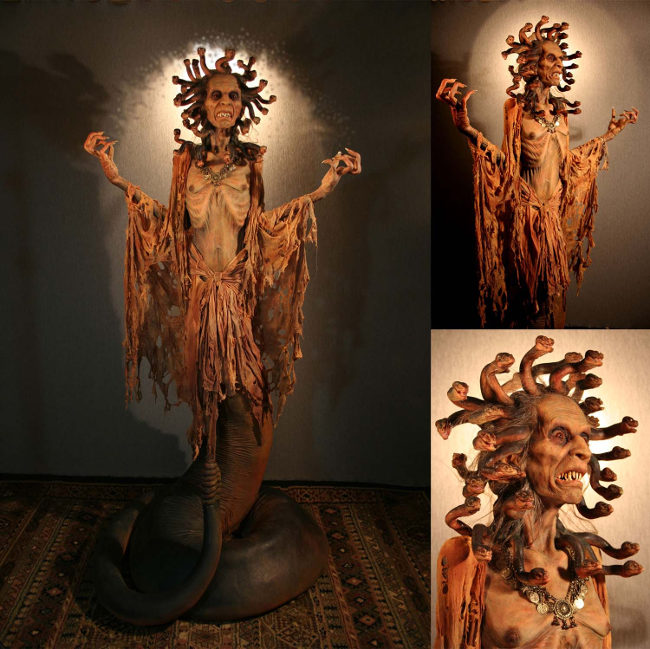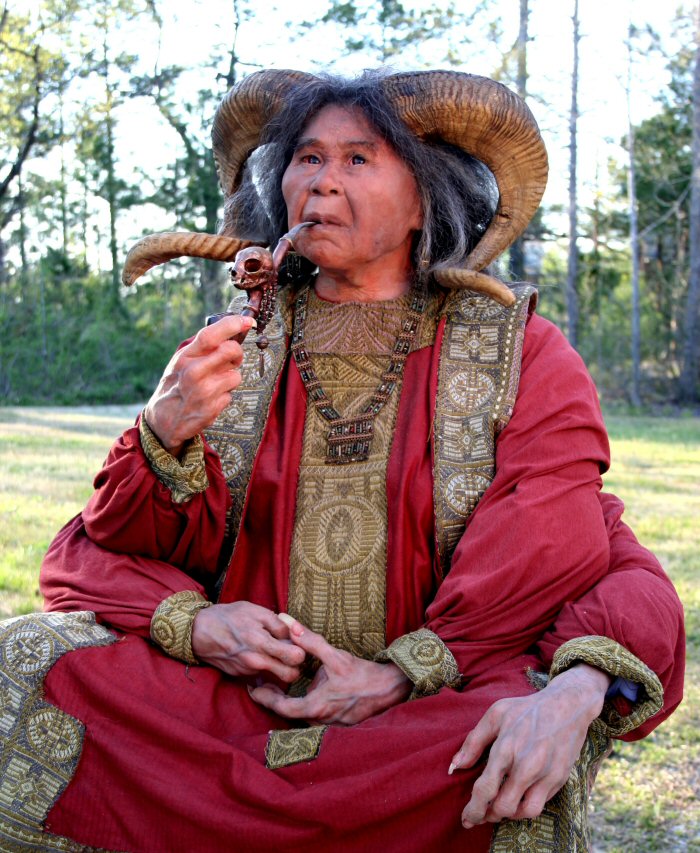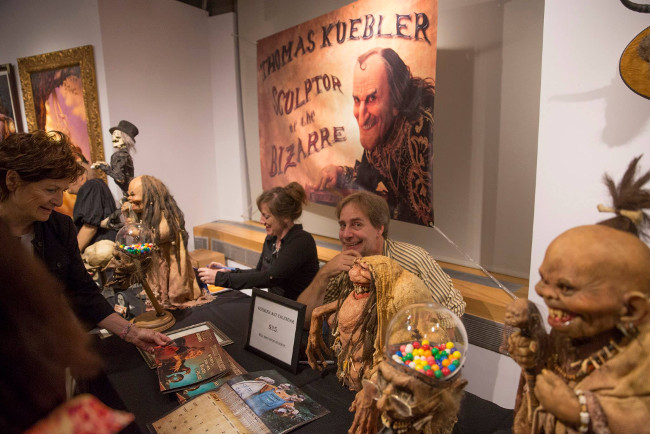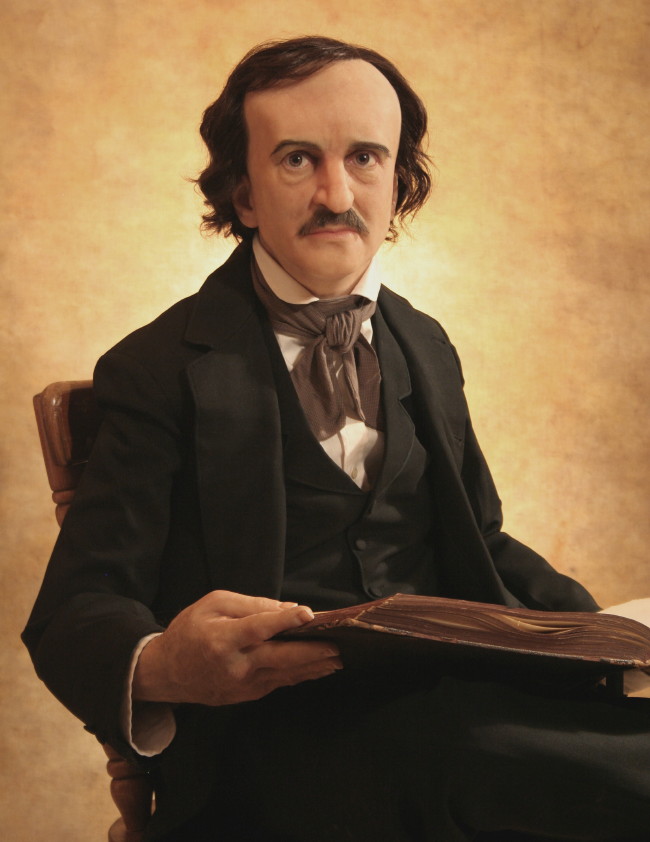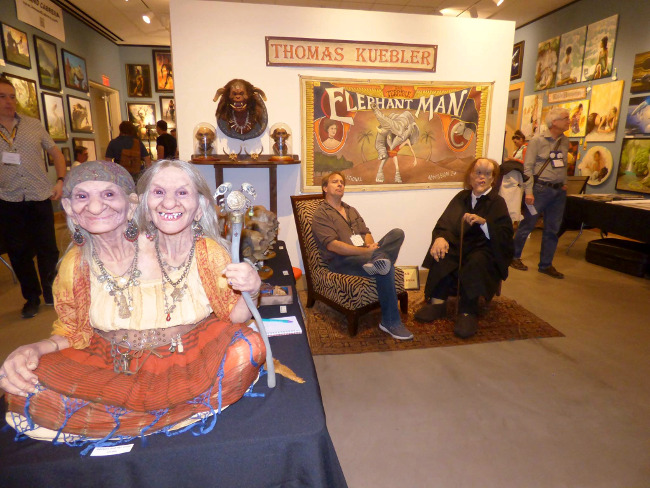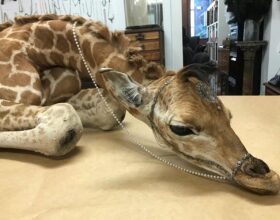 Forget mind-altering chemicals to trigger over-stimulation – put yourself face to face with one of Thomas Kuebler‘s sculptures, so alive that your senses feel heightened, and the stir of excitement cannot be matched. Such is the art of hyperrealism. IX Arts, a leading organisation promoting imaginative realism, has had an integral supportive hand advocating numerous branches of art under this broad yet integral concept, with hyperrealism being no exception. An ongoing project has included specially commissioned pieces for each annual IX art show. Though traditional painting is a predominant feature, IX Arts has commissioned and shared sculptures including the astounding work of Kuebler, who created the 6ft tall Medusa for last year’s 2016 event.
Forget mind-altering chemicals to trigger over-stimulation – put yourself face to face with one of Thomas Kuebler‘s sculptures, so alive that your senses feel heightened, and the stir of excitement cannot be matched. Such is the art of hyperrealism. IX Arts, a leading organisation promoting imaginative realism, has had an integral supportive hand advocating numerous branches of art under this broad yet integral concept, with hyperrealism being no exception. An ongoing project has included specially commissioned pieces for each annual IX art show. Though traditional painting is a predominant feature, IX Arts has commissioned and shared sculptures including the astounding work of Kuebler, who created the 6ft tall Medusa for last year’s 2016 event.
“We’ve known Tom Kuebler since the very first IX show back in 2008,” explains Pat Wilshire, who founded IX Arts with his wife Jeannie. “We were familiar with his work before that […] When we decided to do IX, we reached out [and] were thrilled when he accepted the invite to that first show, and he’s attended every single IX since then. Tom had actually been on our list for an IX commission since the very beginning, but we wanted to give him the opportunity to create a really magnificent, major piece for the show, so we had to wait some years until our commission budget matched what we wanted to allow him to do. As soon as it did, we immediately went forward with the piece.
Medusa (2016)
What amazes us the most about Tom’s work is his ability to always capture the central “character” of whatever he is sculpting, regardless of how bizarre or monstrous that may be. Medusa is a dark, evil character, but Tom’s conceptual skills elevate her from a generic “monster” to a truly terrifying and beautiful individual, where every piece and part of her, from the worm-like snakes, to her desiccated body, to the clothing and adornments, is carefully thought out and considered to produce his unique vision of a well-known creature. Medusa has been depicted a million times over the last 2000 years, but Tom’s Medusa is his own.”
I spoke with Tom to find out more about his experiences as an IX Arts commissioned artist and sculptor.
You’ve had quite a career as a sculptor which led to you being an IX-commissioned Artist at last year’s event (2016). Did you find that the commission opened up any new opportunities to you?
This kind of work creates hidden ripples on the pond that I don’t always see. Somebody may have seen this piece and told somebody who told somebody and on and on, and by the time it got to that next commission I’d never know how the seed was really planted. That’s how most sculptor’s careers work. So it’s important to keep working regardless of commissions. The one thing it really did was force me to try new things to achieve my results. I had a vision that I didn’t want to compromise and had to create new molding techniques outside of my comfort zone. I grew substantially from this piece.
Pat tells me you were the first sculptor ever to be commissioned for IX, even if you were the second to actually be used for the show; how does that feel?
There are more 2D artists than sculptors out there in the world. That fact is reflected by the distribution of artists in art exhibitions, conventions and publications. To be selected for an IX commission, out of a large pool of accomplished artists, is an honor. To be chosen as a representative of 3D artists, is a greater thrill yet.
Zoga the Oracle
What was the commissioned experience like? Were you expecting Pat and Jeannie to approach you with such an offer?
I’ve been coming to IX since the very first show, and to tell you the truth, I didn’t have the annual commission in my sights. I knew it was out there as a possibility, but I didn’t anticipate it. I LOVE this show, so I was always busy planning my next IX exhibit anyway. For me, IX is like being a little 8 year old who gets to show off my own stuff at Disney World! So many of the IX attendees were established artists I grew up admiring as a young adult! So it was a wonderful surprise, but it certainly was not expected.
Though Medusa wasn’t shown until last year’s event, Pat and Jeannie approached you in 2013. Did you spend a lot of this time working on the piece or did the three year gap allow a more relaxed pace to design and build your sculpture?
When they first approached me, they asked about doing my version of the Hindu goddess Kali. I thought about it and realized this might be an opportunity to create a piece I’d always wanted to sculpt. I’d wanted to make my version of a very ambitious sculpture of Medusa for years, and I thought the Wilshires might be willing to change the request. Before I got six words into my sales pitch, Pat said DO IT!! I wanted to hug him. He knew I’d pour my guts into this piece. This was a character that had intrigued me as a child, and I’d thought about it forever. I just needed an excuse to pull the trigger. As far as actually starting the piece, I really began engineering the sculpture before I ever picked up a tool. There were a lot of new challenges in this piece that required research and planning. One mistake could undo weeks of hard work. Also the piece was quite large so I had to complete other commissions I had first so I could devote myself and my workspace only to her. So the planning and preparations lasted that full first year before digging in and physically getting her started.
Medusa (close up)
Tom at IX7 (photo courtesy of Pat Wilshire)
Going back to the beginning, your career in character sculptures evolved after years in the corporate art world making toy design prototypes and animatronics. I always wondered, how do you get into a career making toys and robots?
When I graduated college, I was terrified. I was living with my parents, and they wanted me out. They didn’t care for the fact that I’d earned a studio art degree as opposed to a degree in graphic design. My parents’ generation put the word “starving” in front of the word “artist”. I found Deering Art Gallery at our local mall in the mid-1980’s and presented my life-size polyform and papier mache sculptures to Cindy Deering and she loved them. Tom Wilson, of Ziggy fame, was a good friend of hers and a silent partner, of sorts, in the gallery. He bought my first big piece. He was a wonderful guy, and we got along famously. He also was one of the co-creators of American Greetings’ toy division, Those Characters from Cleveland. He made the introductions, and after doing some freelance work for them, they hired me full time as a concept artist.
I shared an office with the prototype maker. He was a wonderful old WW2 veteran named Elmer Koch. I was supposed to be at my drawing board working, but I followed him around like a puppy in the shop as he made molds and castings, and he taught me all the basics. I was a hardheaded greenhorn kid that had a hard time with committee art direction, and long story short, I was let go after four years. Around that time, an old college friend introduced me to a guy who was making animatronic robots for a trade show display company. I moved to Toledo, Ohio and started working with him. He eventually bought out our department and went on to start Lifeformations. I learned a lot, but as the company grew, I had less and less creative control. I left there in 2001 and basically had to start over. Through all of this, I kept sculpting people and creatures in my garage and did my own thing. I learned a lot from both of these jobs on a technical level. Above all, I learned that I function best when left alone to do my thing.
On your website, you explain how you ‘want to tell wild stories in a single three-dimensional portrait’. Did you find your storytelling mindset was nurtured during this time designing toys, or did it limit you from what you really wanted to do?
Like every artist, I knew I was going to have to do a lot of dues paying to be able to do the things I wanted to do. In my jobs, I learned as much as I could about the mediums necessary to do my own work, but still my artist’s ego crept over and argued with my directors, and that’s not a smart thing in a corporate job. You can carefully persuade but not forcibly bulldoze your artistic opinions. The longer I live and the more I talk to other artists in the corporate and commercial world, from movie FX to toy design, I become more convinced that if you want to do something completely OF your own, you have to do it ON your own.
Once Upon A Midnight Dreary – Edgar Allan Poe
I imagine that your journey to becoming a multi-media sculptor involved a lot of experimentation and development; what is the hardest challenge you have had to face as you’ve carved your independence as an artist?
Almost from the time I left the womb, I’ve been an artist. It really was the only thing I was interested in or any good at. I loved working with my hands, and I busted up all my toys as a kid to remake them the way I wanted. So, the experimentation side of things was always fun for me even when it failed. I’ve had some heart crushing failures that undid two weeks of work in seconds, but I picked up quickly and moved on. The absolute hardest part of this was building my brand. I had to start over at 41 years of age in a whole different market after leaving Lifeformations. Fortunately, I married Kara around that time, and she did everything she could to help me with that. She got a graphic designer friend of hers to help build my first website. It was awesome and just as good as if I hired a professional website builder like B12! She learned every marketing tool she could get her hands on and now manages the website and all of the other advertising on her own. I give lots of creative input, of course, but she handles the technical stuff and gets pretty creative as well. It’s been a slow, steady, hard climb with some setbacks but that’s what makes it so rewarding.
Was there any time that you thought you would pack it all in?
HELL YEAH! A bunch of times! I’ve locked up molds because I forgot to put wax in parting lines and destroyed weeks of work in seconds. I’ve had things go wrong in the final hours of making big expensive pieces with looming deadlines that had me screaming and pulling my hair out. But, then I remember there is no net under my high-wire act, and I hang on. Consequently, most of those “pack it all in” fits last about 15 minutes. Hyper-realistic sculpture gets very complicated and delicate. There is so much that can and does go wrong that at times it doesn’t seem worth it. Then I remember how much love and passion I put into this deal and how much fun I’ve had.
Krampus
I love the subcategories on your website, which include the likes of ‘Beggars & Freaks’ and ‘Monsters & Madmen’. What draws you down these avenues into the dark and the bizarre?
From my earliest memories, I’ve always loved horror. It was Halloween memories and watching the old classic monster movies with my dad as a kid. The stories behind the monsters were so fun and interesting. Even Christmas always involved my brother and I building and painting Aurora monster models in the basement. I’ve never grown out of it. Working on this stuff takes me back to my childhood to the point that I actually make sound effects and do creepy voices while I sculpt. Getting to be a big kid with more sophisticated tools and mediums to build big scary toys is an awesome way to make a living!
Your piece Adelpha and Her Sister has become the core for an interesting interactive project at Krab Jab Studio in Seattle – was this new ground, or have your sculptures been created to display or collaborate with others before?
Well, my career in the animatronics field was all about collaboration for the most part. When Julie Baroh purchased the sculpture for Krab Jab I had no idea she had such big plans for it, but I’m overjoyed that she did. I love that my work brings out that kind of energy and enthusiasm in other artists. That’s one of the biggest reasons I do what I do.
Adelpha and Her Sister
Tom at IX8 (photo courtesy of Pat Wilshire)
Have you found any particular inspiration from other artists that helped to inspire or keep you going?
Getting to know Greg Hildebrandt has had a huge effect on me in that he is so passionate and adventurous about his work. He gives off the most positive vibe I’ve been around, and as an artist prone to depression, I really need that. I know he had to consciously develop that. He’s had to face down a lot of adversity. His wife, Jean Scrocco, is a maestro of art marketing! She’s also a huge influence on me in that she is fearless! She’s a straight talker and has molded a confidence in me that I didn’t have before getting to know her and Greg. Both of them have shown me how lucky we are to be artists even through the rough spots.
Raoul Vitale is a painter that taught himself to paint, and his work is phenomenal! He’s become like a brother to me. He always brought his son Santino to IX from the time he was a young boy, and over the years, I’ve watched Santino become an extremely talented artist and filmmaker whom I know will go far. That kind of stuff is so powerful to me. I could write a book about so many of the artists at IX that put wind in my sails. These are just a few examples.
It seems everyone I speak to you has so many positive stories like those; IX has developed into a real community for artists. What was it like when you first visited their annual event?
I knew almost immediately that I wanted to make this experience an ongoing part of my life. I don’t know how to describe it. There was a magic in the air of creativity, inspiration, and comradery that I had not felt previously at any convention or gathering. Maybe it was because it was obvious that it was created unselfishly, out of the love of art. The Wilshires’ passion was palpable from the very beginning. Maybe it was because it was about teaching and inspiring other artists and students as a primary objective. Whatever the case, I knew I wanted to be a part of it because it was, and is, a giving, sharing experience, and these people have become my extended family. Now, I often see and talk with many of them on a regular basis throughout the year. And that family is still growing.
How do you feel the development of the IX annual show has further helped artists?
This is one question about which I could write a book. I know, for myself, my work has benefited substantially from years of doing this show. One of my best friends always told me if you want to be a winner, hang with the winners. I can’t think of a more winning place in my field than IX. It makes me up my game every year more than I ever would have if I had not attended this show. As I mentioned, IX is as much about education and creative rejuvenation as it is about sales. That fact isn’t any less true for the seasoned professionals than it is for the fledgling artists and students. In fact, I think I’ve learned more from the younger artists in recent years in that they really know how to tap into technology and social media.
This is the wonderful thing about IX. Even though there are some legendary artists mixed in with all the rest of us, everybody checks their egos at the door and becomes teachable to all the knowledge under that roof. And to see the improvement in the artists that you get to know is so inspiring! It really is the kind of thing you have to experience to fully understand the power of sharing knowledge. You really do have to give it away in order to keep it.
Tom with Roger Dean, Greg Hildebrandt and the sculpture Dr Calvarium
Hobgoblin


